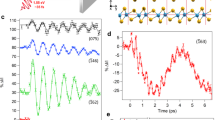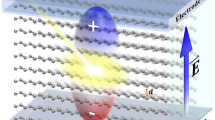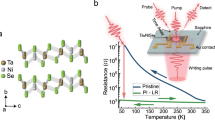Abstract
A better understanding of the carrier formation process for semiconducting polymers, especially in thin films, is essential for designing and constructing highly functionalized polymeric optoelectronic devices. Here, the effects of aggregation states and thermal molecular motion on photocarrier formation in melt-crystallized thin films of monodispersed poly(3-hexylthiophene) (P3HT) are discussed. Grazing incidence X-ray diffraction measurements revealed that the crystalline ordering in the films was greatly influenced by the molecular weight (MW) of P3HT. In contrast, dynamic mechanical analysis (DMA) revealed that the MW had no significant effects on the α1 relaxation process, which corresponded to the twisting motion of thiophene rings in the crystalline phase unless the MW was quite small. Femtosecond transient absorption (TAS) spectroscopy showed that better crystalline ordering led to the direct formation of polarons (P) from hot excitons at room temperature. Once the temperature went beyond Tα1, at approximately 310 K, the P formation process from polaron pairs (PP) was activated. Thus, it can be claimed that the P formation for P3HT could be regulated by the thermal molecular motion in addition to the crystalline structure. The knowledge obtained here should be useful for a better molecular design of semiconducting polymers that can be applied to optoelectronic devices.
This is a preview of subscription content, access via your institution
Access options
Subscribe to this journal
Receive 12 print issues and online access
$259.00 per year
only $21.58 per issue
Buy this article
- Purchase on Springer Link
- Instant access to full article PDF
Prices may be subject to local taxes which are calculated during checkout







Similar content being viewed by others
References
Kim Y, Cook S, Tuladhar SM, Choulis SA, Nelson J, Durrant JR, et al. A strong regioregularity effect in self-organizing conjugated polymer films and high-efficiency polythiophene:fullerene solar cells. Nat Mater. 2006;5:197–203.
Gunes S, Neugebauer H, Sariciftci NS. Conjugated polymer-based organic solar cells. Chem Rev. 2007;107:1324–38.
Thompson BC, Fréchet JMJ. Polymer–fullerene composite solar cells. Angew Chem Int Ed. 2008;47:58–77.
Root SE, Savagatrup S, Printz AD, Rodriquez D, Lipomi DJ. Mechanical properties of organic semiconductors for stretchable, highly flexible, and mechanically robust electronics. Chem Rev. 2017;117:6467–99.
Gu X, Shaw L, Gu K, Toney MF, Bao Z. The meniscus-guided deposition of semiconducting polymers. Nat Commun. 2018;9:534.
Dimitrakopoulos CD, Malenfant PRL. Organic thin film transistors for large area electronics. Adv Mater. 2002;14:99–117.
Braga D, Horowitz G. High-performance organic field-effect transistors. Adv Mater. 2009;21:1473–86.
Kang K, Watanabe S, Broch K, Sepe A, Brown A, Nasrallah I, et al. 2D coherent charge transport in highly ordered conducting polymers doped by solid state diffusion. Nat Mater. 2016;15:896–902.
Wang Y, Zhu C, Pfattner R, Yan H, Jin L, Chen S, et al. A highly stretchable, transparent, and conductive polymer. Sci Adv. 2017;3:e1602076.
Ashizawa M, Zheng Y, Tran H, Bao Z. Intrinsically stretchable conjugated polymer semiconductors in field effect transistors. Prog Polym Sci. 2020;100:101181.
Dimov IB, Moser M, Malliaras GG, McCulloch I. Semiconducting polymers for neural applications. Chem Rev. 2022;122:4356–96.
Mcquade DT, Pullen AE, Swager TM. Conjugated polymer-based chemical sensors. Chem Rev. 2000;100:2537–74.
Higashihara T. Strategic design and synthesis of π-conjugated polymers suitable as intrinsically stretchable semiconducting materials. Polym J. 2021;53:1061–71.
Chen SA, Ni JM. Structure/properties of conjugated conductive polymers. 1. Neutral poly(3-alkythiophene)s. Macromolecules. 1992;25:6081–89.
McCullough RD, Tristram-Nagle S, Williams SP, Lowe RD, Jayaraman M. Self-orienting head-to-tail poly(3-alkylthiophenes): New insights on structure-property relationships in conducting polymers. J Am Chem Soc. 1993;115:4910–11.
Coakley KM, McGehee MD. Conjugated polymer photovoltaic cells. Chem Mater. 2004;16:4533–42.
Liu R, Yang W, Xu W, Deng J, Ding C, Guo Y, et al. Impact of chemical design on the molecular orientation of conjugated donor–acceptor polymers for field-effect transistors. ACS Appl Polym Mater. 2022;4:2233–50.
Chen SA, Liao CS. Conductivity relaxation and chain motions in conjugated conducting polymers: Neutral poly(3-alkylthiophenes). Macromolecules. 1993;26:2810–16.
Diaz Calleja R, Matveeva ES, Parkhutik VP. Electric relaxation in chemically synthesized polyaniline: Study using electric modulus formalism. J Non-Cryst Solids. 1995;180:260–65.
Crist B, Schultz JM. Polymer spherulites: A critical review. Prog Polym Sci. 2016;56:1–63.
Michell RM, Müller AJ. Confined crystallization of polymeric materials. Prog Polym Sci. 2016;54-55:183–213.
Zen A, Pflaum J, Hirschmann S, Zhuang W, Jaiser F, Asawapirom U, et al. Effect of molecular weight and annealing of poly(3-hexylthiophene)s on the performance of organic field-effect transistors. Adv Funct Mater. 2004;14:757–64.
Kline RJ, McGehee MD, Kadnikova EN, Liu J, Fréchet JMJ, Toney MF. Dependence of regioregular poly(3-hexylthiophene) film morphology and field-effect mobility on molecular weight. Macromolecules. 2005;38:3312–19.
Ko J, Kim Y, Kang JS, Berger R, Yoon H, Char K. Enhanced vertical charge transport of homo- and blended semiconducting polymers by nanoconfinement. Adv Mater. 2020;32:1908087.
Ruffino R, Fichera L, Valenti A, Jankowski M, Konovalov O, Messina GML, et al. Tuning the randomization of lamellar orientation in poly (3-hexylthiophene) thin films with substrate nano-curvature. Polymer. 2021;230:124071.
Chou H-C, Fang C-K, Chung P-Y, Yu J-R, Liao W-S, Chen S-H, et al. Structural and optical identification of planar side-chain stacking P3HT nanowires. Macromolecules. 2021;54:10750–57.
Yamagata Y, Benten H, Kawanishi T, Nakamura M. Nanoscale observation of the influence of solvent additives on all-polymer blend solar cells by photoconductive atomic force microscopy. ACS Appl Polym Mater. 2022;4:169–78.
Han MJ, Kim J, Kim B, Park SM, Ahn H, Shin TJ, et al. Orientation control of semiconducting polymers using microchannel molds. ACS Nano. 2020;14:12951–61.
Li N, Song L, Hohn N, Saxena N, Cao W, Jiang X, et al. Nanoscale crystallization of a low band gap polymer in printed titania mesopores. Nanoscale. 2020;12:4085–93.
Choudhary K, Chen AX, Pitch GM, Runser R, Urbina A, Dunn TJ, et al. Comparison of the mechanical properties of a conjugated polymer deposited using spin coating, interfacial spreading, solution shearing, and spray coating. ACS Appl Mater Interfaces. 2021;13:51436–46.
Xiao J, Jia XE, Duan C, Huang F, Yip H-L, Cao Y. Surpassing 13% efficiency for polythiophene organic solar cells processed from nonhalogenated solvent. Adv Mater. 2021;33:2008158.
Abe T, Kawaguchi D, Watanabe M, Hoshino T, Ishihara T, Tanaka K. An effect of crystallographic distortion on carrier mobility in poly(3-hexylthiophene) thin films. Appl Phys Lett. 2021;118:181601.
Kline RJ, McGehee MD, Kadnikova EN, Liu JS, Fréchet JMJ. Controlling the field-effect mobility of regioregular polythiophene by changing the molecular weight. Adv Mater. 2003;15:1519–22.
Li G, Yao Y, Yang H, Shrotriya V, Yang G, Yang Y. “Solvent annealing” effect in polymer solar cells based on poly(3-hexylthiophene) and methanofullerenes. Adv Funct Mater. 2007;17:1636–44.
Lu G, Li L, Li S, Qu Y, Tang H, Yang X. Constructing thin polythiophene film composed of aligned lamellae via controlled solvent vapor treatment. Langmuir. 2009;25:3763–68.
Street RA, Northrup JE, Salleo A. Transport in polycrystalline polymer thin-film transistors. Phys Rev B. 2005;71:165202.
Hu X, Xu L. Structure and properties of 3-alkoxy substituted polythiophene synthesized at low temperature. Polymer. 2000;41:9147–54.
Yazawa K, Inoue Y, Yamamoto T, Asakawa N. Twist glass transition in regioregulated poly(3-alkylthiophene). Phys Rev B. 2006;74:094204.
Pankaj S, Beiner M. Long-term behavior and side chain crystallization of poly(3-alkyl thiophenes). Soft Matter. 2010;6:3506–16.
Xie R, Lee Y, Aplan MP, Caggiano NJ, Müller C, Colby RH, et al. Glass transition temperature of conjugated polymers by oscillatory shear rheometry. Macromolecules. 2017;50:5146–54.
Cao Z, Galuska L, Qian Z, Zhang S, Huang L, Prine N, et al. The effect of side-chain branch position on the thermal properties of poly(3-alkylthiophenes). Polym Chem 2020;11:517–26.
Zhan P, Zhang W, Jacobs IE, Nisson DM, Xie R, Weissen AR, et al. Side chain length affects backbone dynamics in poly(3-alkylthiophene)s. J Polym Sci, Part B: Polym Phys. 2018;56:1193–202.
Ogata Y, Kawaguchi D, Tanaka K. An effect of molecular motion on carrier formation in a poly(3-hexylthiophene) film. Sci Rep. 2015;5:8436.
Obrzut J, Page KA. Electrical conductivity and relaxation in poly(3-hexylthiophene). Phys Rev B. 2009;80:195211.
Wolf CM, Kanekal KH, Yimer YY, Tyagi M, Omar-Diallo S, Pakhnyuk V, et al. Assessment of molecular dynamics simulations for amorphous poly(3-hexylthiophene) using neutron and X-ray scattering experiments. Soft Matter. 2019;15:5067–83.
Ogata Y, Kawaguchi D, Tanaka K. The impact of polymer dynamics on photoinduced carrier formation in films of semiconducting polymers. J Phys Chem Lett. 2015;6:4794–98.
Balar N, Rech JJ, Siddika S, Song R, Schrickx HM, Sheikh N, et al. Resolving the molecular origin of mechanical relaxations in donor–acceptor polymer semiconductors. Adv Funct Mater. 2022;32:2105597.
Guo J, Ohkita H, Benten H, Ito S. Near-IR femtosecond transient absorption spectroscopy of ultrafast polaron and triplet exciton formation in polythiophene films with different regioregularities. J Am Chem Soc. 2009;131:16869–80.
Guo J, Ohkita H, Benten H, Ito S. Charge generation and recombination dynamics in poly(3-hexylthiophene)/fullerene blend films with different regioregularities and morphologies. J Am Chem Soc. 2010;132:6154–64.
Yu W, Donohoo-Vallett PJ, Zhou J, Bragg AE. Ultrafast photo-induced nuclear relaxation of a conformationally disordered conjugated polymer probed with transient absorption and femtosecond stimulated raman spectroscopies. J Chem Phys. 2014;141:044201.
Lee D, Lee J, Song K-H, Rhee H, Jang D-J. Formation and decay of charge carriers in aggregate nanofibers consisting of poly(3-hexylthiophene)-coated gold nanoparticles. Phys Chem Chem Phys. 2016;18:2087–96.
Rana A, Gupta N, Lochan A, Sharma GD, Chand S, Kumar M, et al. Charge carrier dynamics and surface plasmon interaction in gold nanorod-blended organic solar cell. J Appl Phys. 2016;120:063102.
Lee D, Sin DH, Kim SW, Lee H, Byun HR, Mun J, et al. Singlet exciton delocalization in gold nanoparticle-tethered poly(3-hexylthiophene) nanofibers with enhanced intrachain ordering. Macromolecules. 2017;50:8487–96.
Mensik M, Pfleger J, Toman P. Dynamics of photogenerated polarons and polaron pairs in P3HT thin films. Chem Phys Lett. 2017;677:87–91.
Rais D, Mensik M, Paruzel B, Toman P, Pfleger J. Concept of the time-dependent diffusion coefficient of polarons in organic semiconductors and its determination from time-resolved spectroscopy. J Phys Chem C. 2018;122:22876–83.
Rana D, Donfack P, Jovanov V, Wagner V, Materny A. Ultrafast polaron-pair dynamics in a poly(3-hexylthiophene-2,5-diyl) device influenced by a static electric field: Insights into electric-field-related charge loss. Phys Chem Chem Phys. 2019;21:21236–48.
Masunaga H, Ogawa H, Takano T, Sasaki S, Goto S, Tanaka T, et al. Multipurpose soft-material SAXS/WAXS/GISAXS beamline at SPring-8. Polym J. 2011;43:471–77.
Ogawa H, Masunaga H, Sasaki S, Goto S, Tanaka T, Seike T, et al. Experimental station for multiscale surface structural analyses of soft-material films at SPring-8 via a GISWAXS/GIXD/XR-integrated system. Polym J. 2013;45:109–16.
Kayunkid N, Uttiya S, Brinkmann M. Structural model of regioregular poly(3-hexylthiophene) obtained by electron diffraction analysis. Macromolecules. 2010;43:4961–67.
Brinkmann M. Structure and morphology control in thin films of regioregular poly(3-hexylthiophene). J Polym Sci Polym Phys. 2011;49:1218–33.
Brinkmann M, Rannou P. Molecular weight dependence of chain packing and semicrystalline structure in oriented films of regioregular poly(3-hexylthiophene) revealed by high-resolution transmission electron microscopy. Macromolecules. 2009;42:1125–30.
Wu Z, Petzold A, Henze T, Thurn-Albrecht T, Lohwasser RH, Sommer M, et al. Temperature and molecular weight dependent hierarchical equilibrium structures in semiconducting poly(3-hexylthiophene). Macromolecules. 2010;43:4646–53.
Maillard A, Rochefort A. Structural and electronic properties of poly(3-hexylthiophene) π-stacked crystals. Phys Rev B. 2009;79:115207.
Lindenmeyer PH, Hosemann R. Application of the theory of paracrystals to the crystal structure analysis of polyacrylonitrile. J Appl Phys. 1963;34:42–45.
Hosemann R, Hindeleh AM. Structure of crystalline and paracrystalline condensed matter. J Macromol Sci Part B. 1995;34:327–56.
Zhang L, Elupula R, Grayson SM, Torkelson JM. Suppression of the fragility-confinement effect via low molecular weight cyclic or ring polymer topology. Macromolecules. 2017;50:1147–54.
Angell CA. Relaxation in liquids, polymers and plastic crystals—strong/fragile patterns and problems. J Non-Cryst Solids. 1991;131-133:13–31.
Roland CM, Nagi KL. Segmental relaxation in poly(dimethylsiloxane). Macromolecules. 1996;29:5747–50.
Saiter JM, Dargent E, Kattan M, Cabot C, Grenet J. Fragility index of drawn or annealed poly(ethylene terephthalate) films studied by thermally stimulated depolarisation currents. Polymer. 2003;44:3995–4001.
Kanaya T, Tsukushi I, Kaji K. Non-Gaussian parameter and heterogeneity of amorphous polymers. Prog Theor Phys Supp. 1997;126:133–40.
Yuan S, Schmidt-Rohr K. Immobilized 13C-labeled polyether chain ends confined to the crystallite surface detected by advanced NMR. Sci Adv. 2020;6:eabc0059.
Acknowledgements
This work was supported by JSPS KAKENHI for Scientific Research (B) (No. JP20H02790) to KT and Scientific Research (B) (No. JP20H02802) to DK from the Ministry of Education, Culture, Sports, Science, and Technology (MEXT), Japan. We are also thankful for the support from the JST-Mirai Program (JPMJMI18A2) (K.T.). GIWAXD measurements were carried out at BL03XU at SPring-8 constructed by the Consortium of the Advanced Softmaterial Beamline (FSBL) (Proposal No. 2016A7225, 2016B7273, and 2021A7217).
Author information
Authors and Affiliations
Corresponding authors
Ethics declarations
Conflict of interest
The authors declare no competing interests.
Additional information
Publisher’s note Springer Nature remains neutral with regard to jurisdictional claims in published maps and institutional affiliations.
Supplementary information
Rights and permissions
Springer Nature or its licensor holds exclusive rights to this article under a publishing agreement with the author(s) or other rightsholder(s); author self-archiving of the accepted manuscript version of this article is solely governed by the terms of such publishing agreement and applicable law.
About this article
Cite this article
Kawaguchi, D., Higasayama, A., Ogata, Y. et al. Crystalline structure, molecular motion and photocarrier formation in thin films of monodisperse poly(3-hexylthiophene) with various molecular weights. Polym J 55, 497–505 (2023). https://doi.org/10.1038/s41428-022-00713-0
Received:
Revised:
Accepted:
Published:
Issue Date:
DOI: https://doi.org/10.1038/s41428-022-00713-0



